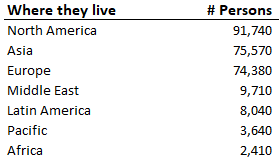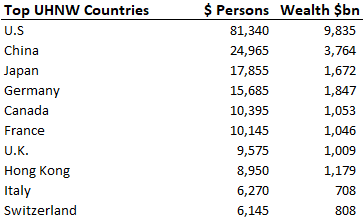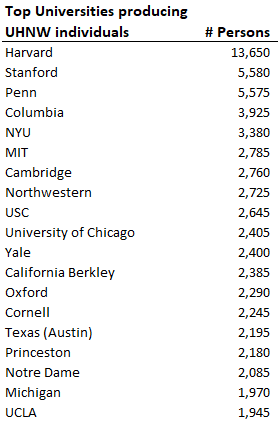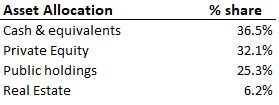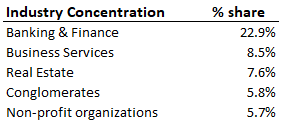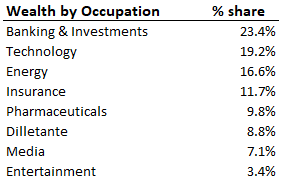According to the latest report from Wealth-X, The Global Leader in Wealth Information and Insight, the wealthiest one-tenth of one percent of people in the world now control $32 trillion of all the money invested in public and private securities that are available to investors.
In this article I'll drill down into who these people are, where they live, where they went to school, and other characteristics. The purpose of this article is to shine some light on who makes up the elite of the elite class around the globe.
I make no value judgments about the issues of wealth inequality. I leave that up to you. I will only present the data.
Unpacking the data from Wealth-X
Table 1. Where they live
It's no surprise that North America is home to the largest cohort of these ultra-rich investors. But Asia, especially China, is nipping at the heels and getting ready to overtake North America as the center of invested wealth in the world.
Table 2. The Tiers of wealth
Membership in the UHNW club is exclusive, to put it mildly. Just to make it to the bottom rung of the ladder you need a minimum of $30 million of invested wealth. The rest of the higher-ups consider your substantial wealth as not much more than chump change.
What does it take to get a seat at the cool kids table? The table below spells it out clearly.
Table 3. Sources of wealth
You may have made it to the bigs by winning the state lottery, or maybe you're a highly skilled bank robber. But most UHNW investors were either self-made, lucky heirs to the family fortune, or some combination of the two.
As the table shows, the purely self-made cohort is twice as large as the other two.
Table 4. Drilling down to specific countries
Again, the U.S is the home of the largest of ultra-wealthy investors. However, with each passing year the Chinese mint more multi-millionaires. It will take several years for them to overtake the U.S. but they will undoubtedly get there.
Table 5. Where did these elites go to college?
You don't need a college degree to make it into the UHNW club, but it helps if you graduated from a top school. Why? Not because you came out smarter than your less fortunate high school friends. It's because these top schools have powerful alumni networks, and making it to the big time requires highly-placed connections.
Table 6. Wealth by Gender
Does it surprise anyone that the ratio of males to females in the UHNW club is 9 to 1? Welcome to the Patriarchy of wealth. But women are gaining ground each year - slowly but consistently.
Table 7. Where do the elites invest their money?
Starting with a macro view, these investors are very conservative and risk-averse. No surprise here. Why try to be a hero by gambling your fortune in the market when you already have enough stashed away to keep you comfortable until you finally tip over? For these elites, cash is king and that won't change anytime soon.
Table 8. Drilling down a little further
A 36% allocation to cash leaves 64% available to risk assets. Where do these elites go to find risk assets? The table below has the answer.
Table 9. Wealth by Occupation*
One of the primary determinants of wealth accumulation is the occupation chosen by the investor. As the table below shows, the top earning and wealth creating occupations are in banking and investments. A quick scan of the Forbes list of billionaires supports this idea.
Technology moguls like Larry Ellison, Jeff Bezos, and Mark Zuckerberg are examples of Tech Billionaires.
Final Thoughts
I'm aware that this article has probably rankled many of you, but I'm here to inform and educate. The issue of wealth inequality is so important that it must be open for discussion and debate in every venue where thoughtful people congregate. I hope this forum is one of those places.
If you are willing to indulge me for just a minute, here are my thoughts on the issue. As long as we have a capitalist economic system, wealth inequality will remain a fact of life. I'm a capitalist, but I also believe that today's imbalance between the ultra-wealthy and the rest of the populace is unhealthy and dangerous.
The ultra-wealthy will argue that they give back to society with charitable donations and paying taxes. Well, I'm going to have to go ahead and call bullshit on that. The folks who argue that point of view are usually the ones who contribute the minimum required to get an award, and hire high-priced tax attorneys to find every angle they can to avoid paying their fair share of taxes.
In my view, we need a thriving middle class to keep our economy humming and the stock market rising. But I think we've lost our way. Remember what John F. Kennedy said:
John F. Kennedy’s inaugural address inspired children and adults to see the importance of civic action and public service. His historic words, “Ask not what your country can do for you – ask what you can do for your country,” challenged every American to contribute in some way to the public good.
* Wealth by occupation was not part of the Wealth-X report. The numbers are from the Bureau of Labor Statics and the OECD.
** Wealth by religious affiliation was not part of the Wealth-X report. The numbers are from the wealth reports of each religious group.

